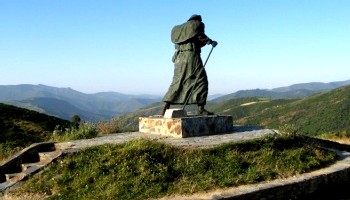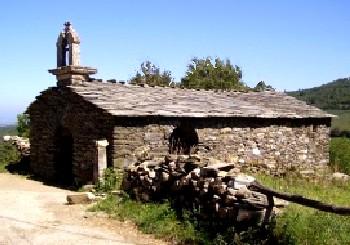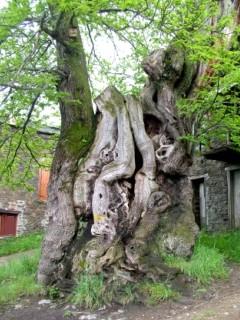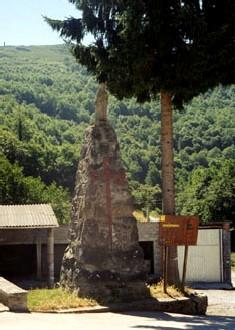Camino de Santiago - French Way - Stage 28, page 1
O Cebreiro to Samos
Total distance - 29.5 km
From O Cebreiro you take the main road towards your next stop, the village of Liñares which is about 3 kilometres away. Here there is a small café, a shop and the small 12th century church la Igrexa de Santo Estevo. Accommodation can be found at a casa rural. You will note as you walk through Galicia that all signage is now in Gallego (Galician), very rarely will you see any signage with the Spanish alternative on it so I will give you the Galician name from here on in. Most guide books still seem to provide the Spanish name which may confuse the traveller.

Walk through the village and join the road at the end following the markers to a rough track which runs parallel with the road. The path now climbs steeply for a kilometre up to the Alto de San Roque. Up here you will get fabulous views across the mountains, on a clear day that is. There is a small chapel to San Roque but the most photographed image is that of the large bronze statue of a pilgrim facing towards Santiago, holding onto his hat against the wind.
The path continues climbing and after 1.5 kilometres you reach the small village of Hospital da Condesa. As the name suggests there used to be a pilgrim hospital here, built in the 9th century by Doña Egilo, the wife of Conde Gantón. The small church Igrexa de San Xoan, like the one up in O Cebreiro was restored in the 1960's. There is a small modern albergue here along with a café, but the café is not always open.
Walk through to the end of the village and down a minor road sign posted to Sabugos. This will take you along a lane and then a track through the small hamlet of Padornelo. Once through the hamlet the track begins to climb steeply towards the Alto do Poio 3 kilometres away.
In Alto de Poio there is an Albergue which is situated at the back of the Café Puerto, you need to ask at the bar first. If you happen to be doing the Camino in the autumn/winter you will always find a roaring log fire going in the bar to warm you up. There is also a private hostal/restaurant in the village and a small shop.
Walk through the village and down the road forking right to walk down a track parallel to the road down to the village of Fonfría in 3.5 kilometres. The village gets its name from its fountain Fons Frigida or cold spring. During the 16th century there used to be a pilgrim hospital here that would give heat, salt and water and a bed with two blankets to healthy pilgrims and to the sick a piece of bread, eggs and butter as well. In the small church there is a 17th century silver chalice which has engraved on it “Soy hospital de Fon Fría”. For modern pilgrims the local albergue offers a bed for the night as well as a good pilgrim menu and breakfast in the morning. There is also another café in the village but this is only open during the summer months and a couple of casa rurales.

Thankfully from here until Triacastela the Camino starts to descend. From Fonfría walk down a track parallel to the road and then follow the markers into the small village of Biduedo. There are a couple of hostals here, one of which has a bar/restaurant. There is a tiny chapel dedicated to San Pedro on the side of the road.

The track now descends down to the small hamlet of Filloval and then on through to the hamlet of As Pasantes where you will find a small hostal and an unusually shaped chestnut tree that locals claim to be around 800 years old.
You continue down the track downhill into Ramil and through the hamlet for about 6.5 kilometres passing a refugio at the entrance to the small town of Triacastela.
The town of Triacastela is said to have been founded in the 9th century by Conde Gatón, the same man whose wife built the pilgrim hospital at Hospital da Condesa, but there are remains of Castros (hill forts) in the area which shows that the area was inhabited many thousands of years before. The king Alfonso IX thought of Triacastela as an important strategic town in what he called los Alpes Gallegos, or the Galician Alps. The name of Triacastela could come from three castles that may have stood here, but there are 3 castros, Triacastela, Lagares and San Adrián in the vicinity so it could also refer to them, in any case all that remains of these is their symbol on the town's coat of arms.

Most of the tourist sites in Triacastela have a link to the Camino. The main one is that of the Pilgrim Monument. During the Middle Ages when the cathedral was being built in Santiago it was tradition that the pilgrims travelling through Triacastela would pick up limestone and take it along with them to the lime kilns in Castañeda, nearly 100 kilometres away. That way each pilgrim would feel that they have contributed to the construction and maintenance of the Saint's resting place.
The town used to have a number of pilgrim hospitals but only one of those remain and that is now being used as a private house I believe. There are a number of places where you can stay including 4 albergues and 4 hostals and various restaurants and café/bars.
As you leave Triacastela at a T-junction you are given a choice of 2 routes towards Sarria. The left hand route takes you to the impressive monastery at Samos which is our preferred route. It is about 11 kilometres but the monastery there is one of the most impressive buildings I have seen and well worth a visit. The right hand route takes you through a more rural route towards San Xil. Both routes meet a few kilometres before Sarria and are clearly marked, though only the San Xil route has those marker stones we mentioned before.

